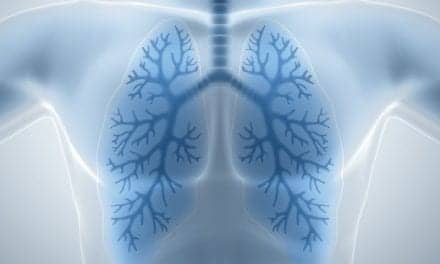New and beneficial treatments that were introduced in the 1990s contributed to significant progress in helping physicians to understand and treat cystic fibrosis.

In past decades, there was some discussion of nebulizing antibiotics intended for intravenous use. In the 1990s, this idea was the subject of major research that resulted in significant changes in practice patterns. The reasons for considering nebulization of antibiotics include: delivery of a drug without the need for intravenous access, increasing the local concentration of the antibiotic to improve its effectiveness, and avoiding systemic toxicity (such as the hearing loss and kidney damage seen with the use of systemic aminoglycosides). Although a number of antibiotics have been delivered via nebulization for CF patients, tobramycin has seen the most use and study. It is an effective antipseudomonal that works synergistically with other antibiotics. It is often given in combination with a second antibiotic in an effort to decrease the risk of developing resistance, but recently it has become widely used alone as chronic intermittent therapy. In a study3 of 520 patients randomized to inhaled tobramycin or placebo in cycles of 28 days on and 28 days off, tobramycin had a very significant impact on bacterial density in sputum and on lung function. According to recent unpublished reports, its impact is persistent. There was little increase in bacterial resistance, but whether this will hold true with prolonged use is an open (and very important) question. Currently, about 55% of US CF patients use tobramycin.4
Perhaps as important as deciding how to treat exacerbations of lung infection in CF are defining an exacerbation and determining when to treat it. In Denmark, for example, CF patients survive longer, on average, than they do in North America.5 Danish researchers argue that this is due, in large part, to the aggressive use of antipseudomonal antibiotics. Danish clinicians attempt the eradication of Pseudomonas infection when it first appears with long courses of oral ciprofloxacin and inhaled tobramycin. Those patients chronically infected by Pseudomonas are treated with intravenous antibiotics at least every 3 months, regardless of the clinical status of the patient. Because the Danish situation is unique and because Danish infection-control practices differ from those used in North American centers, it is not possible to determine which factors account for the longer survival of patients in Denmark.
Perhaps the more pressing issue in North America is achieving a universally accepted definition of a pulmonary exacerbation to be used in conjunction with consistent treatment of worsening lung infection. According to data from the Epidemiologic Study of Cystic Fibrosis (ESCF),6 initiation of treatment for deteriorating lung function is incredibly inconsistent. Although some have argued that a loss in FEV1 of 10% is reason enough to start treatment, many patients are not treated until the loss is two to three times greater. Of course, the ESCF data do not include many of the individual factors that might have affected such decisions, such as a patient’s refusal of treatment due to lack of time or money. Another important and controversial aspect of acute treatment of infection is whether exacerbations can be treated at home as well as they can be treated in the hospital. A number of studies have unsuccessfully addressed this question; more research is urgently needed. In the United States, the urgency results from the pressure to cut costs that is exerted by managed care organizations. Home care is seen as a less expensive alternative to the traditional 10-day to 14-day hospital stay. The published data7 suggest that home care is not effective in all cases, and that good nursing care and respiratory therapy support for home care are essential to its success. Insurance plans, in general, do not pay for the kind of support that probably is needed to make home care consistently effective.
Airway-clearance techniques
Postural drainage and chest physiotherapy, as practiced in North America, have been mainstays of the treatment of CF for many years. A need for techniques that allow more independence of patients is the result of successful treatment of CF (and longer survival). During the 1990s, a number of such techniques were applied to CF with increasing frequency. These included active cycle of breathing, autogenic drainage, a variety of positive expiratory pressure devices intended to facilitate mucus clearance, high-frequency chest-wall oscillation, and intrapulmonary percussive ventilation. The evidence for effectiveness of these techniques is confusing and conflicting. Most of what are referred to as studies of these techniques are actually anecdotal, and the few controlled and comparison trials8,9 do not show any significant differences in clinical outcomes between treatment and control groups. A large, multicenter comparison study of postural drainage, positive expiratory pressure, and high-frequency chest-wall oscillation is under way; it may shed some light on at least part of this puzzle.
It is likely, however, that no one technique is clearly superior in all patients, and personal preference will continue to be a major factor in deciding which technique to use. It is clear that something is always better than nothing where mucus clearance is concerned, and enthusiasm for learning any new technique can be useful and productive for CF caregivers and patients. Promoting independent living is also important to the self-perception, optimism, and maturation of CF patients.
Lung transplantation
When, in spite of aggressive treatment, lung function deteriorates to unsustainably low levels, lung transplantation becomes an option for some patients. Transplantation has been applied in CF for more than 10 years, with peak utilization occurring in about 1995.10 Initial fears about overwhelming infection and recurrence of CF in the transplanted lungs proved to be exaggerated, but transplantation does not provide a good solution to the problem of deteriorating lung function, as it substitutes one new set of problems for the old. Further, it is not clear that transplantation has improved overall survival, and some preliminary evidence has been presented in national meetings that suggests only the very sickest patients actually benefit from lung transplantation.
FEV1 of less than 30% of the predicted value generally has been used as the main referral criterion. This is based on a retrospective Canadian study11 that suggested a 50% risk of death within 2 years for patients with FEV1 results of less than 30% of the predicted value, Po2 levels of less than 55 mm Hg, and Pco2 levels of more than 50 mm Hg. The predictive value of these criteria currently is being called into question. In coming years, new criteria should emerge that will allow better prediction of who will benefit.
A number of factors can eliminate a patient from consideration for transplant receipt. Multiorgan failure, poor nutritional status, portal hypertension, and the presence of B. cepacia are a few of these. The presence of psychiatric illness or the lack of social and financial resources is also important. Having had prior chest surgery might eliminate a patient from consideration. Each transplant center varies somewhat in its criteria, so patients occasionally shop for a center that will accept them.
Currently, about one in four CF patients accepted for transplantation actually undergoes the procedure.12,13 The majority die before an acceptable organ becomes available. Recently, the use of living donors has been promoted at some centers. The advantages are obvious—and the ethical questions, legion. In living-donor transplantation, a lower lobe from each of two donors is used. The outcomes appear to be comparable to those for cadaveric lung transplantation.14
There are many important complications of lung transplantation that limit its short-term and long-term benefits. Mortality in the perioperative period approaches 5%. First-year survival is about 75%, and 4-year to 6-year survival is about 40%. Half of patients surviving for 5 years after surgery have bronchiolitis obliterans as a result of chronic rejection; many patients at this stage return to using supplemental oxygen.15 Chronic cytomegalovirus pneumonia is a problem for some transplant recipients, and an increasing number of malignancies have been reported in these patients. Malignancy in a transplant patient is untreatable. For those patients whose lungs fail too quickly and who choose a second transplant, 1-year survival after the second surgery is about 45%.15
Improvements in management and outcomes for lung transplantation are likely, but the amount of improvement that can be expected is unclear because the lung is an immunologically active organ. Perhaps that is why lung transplantation is associated with shorter survival than kidney, heart, or liver transplantation.
CF care and research networks
Much of the progress in CF research and care has happened as a direct result of the efforts of the Cystic Fibrosis Foundation. It has raised many millions of dollars for research over the past decade. It is now sponsoring well over 100 studies covering a wide range of subjects relevant to CF. It has low overhead, spending 90% of all donations for research. It has recruited many researchers into the field and has fostered high-quality care through the CF care network and the annual North American CF conference. The foundation created the Research Development Program grants, awarding funding to 10 centers around the country that have dedicated considerable resources to CF research. It created a Therapeutics Development Network composed of seven centers to facilitate phase I and II trials for new CF treatments, and (jointly, with the National Institutes of Health) it sponsors eight gene-therapy centers. Among all that was accomplished in the 1990s, the foundation can be justly proud of its role in bringing CF to the forefront of research and public awareness.
Dennis W. Nielson, MD, PhD, is director, division of pulmonary medicine, and director, cystic fibrosis center, The Children’s Medical Center, Dayton, Ohio; professor of pediatrics, Wright State University School of Medicine, Dayton; and chair, Ohio Cystic Fibrosis Consortium.
References
1. Cystic Fibrosis Foundation. Patient Registry—1999. Bethesda, Md: Annual Data Report; 1999.
2. Frederiksen B, Koch C, Hoiby N. Changing epidemiology of Pseudomonas aeruginosa infection in Danish cystic fibrosis patients (1974-1995). Pediatr Pulmonol. 1999;28:159-166.
3. Ramsey BW, Pepe MS, Quan JM, et al. Intermittent administration of inhaled tobramycin in patients with cystic fibrosis. N Engl J Med. 1999;340:23-30.
4. Study Center Report. Epidemiologic Study of Cystic Fibrosis. Cary, NC: Clintrials Inc; 1999.
5. Frederiksen B, Lanng S, Koch C, Hoiby N. Improved survival in the Danish center-treated cystic fibrosis patients: results of aggressive treatment. Pediatr Pulmonol. 1996;21:153-158.
6. Wohl ME. Lecture presented at: Investigator’s Meeting, Epidemiologic Study of Cystic Fibrosis; October 24, 1997; Nashville, Tenn.
7. Bosworth DG, Nielson DW. The effectiveness of home versus hospital care in the routine treatment of cystic fibrosis. Pediatr Pulmonol. 1997;24:42-47.
8. Pryor JA. Physiotherapy for airway clearance in adults. Eur Respir J. 1999;14:1418-1424.
9. Prasad SA, Main E. Finding evidence to support airway clearance techniques in cystic fibrosis. Disabil Rehabil. 1998;20:235-246.
10. Cystic Fibrosis Foundation. Double-lung transplantation in cystic fibrosis patients in the United States from 1988 through 1999. Bethesda, Md: Patient Registry; 1999.
11. Kerem E, Reisman J, Corey M, et al. Prediction of mortality in patients with cystic fibrosis. N Engl J Med. 1992;326:1187-1191.
12. DeMeester J, Smits JM, Persijn GG, Haverich A. Lung transplant waiting list: differential outcome of type of end-stage lung disease, one year after registration. J Heart Lung Transplant. 1999;18:563-571.
13. Yankaskas JR, Mallory GB, and the Consensus Committee. Lung transplantation in cystic fibrosis. Chest. 1998;113:217-226.
14. Starnes VA, Barr ML, Cohen RG. Lobar transplantation indications, technique and outcome. J Thorac Cardiovasc Surg. 1996;112:1284-1291.
15. St Louis International Lung Transplant Registry. January 1997 Report. St Louis: Washington University School of Medicine; 1997.









